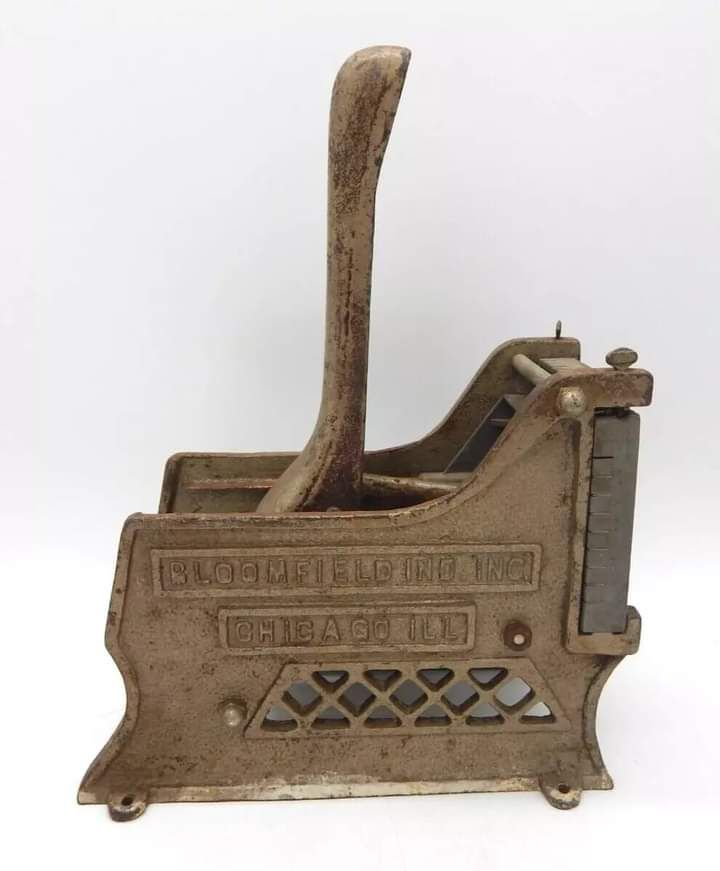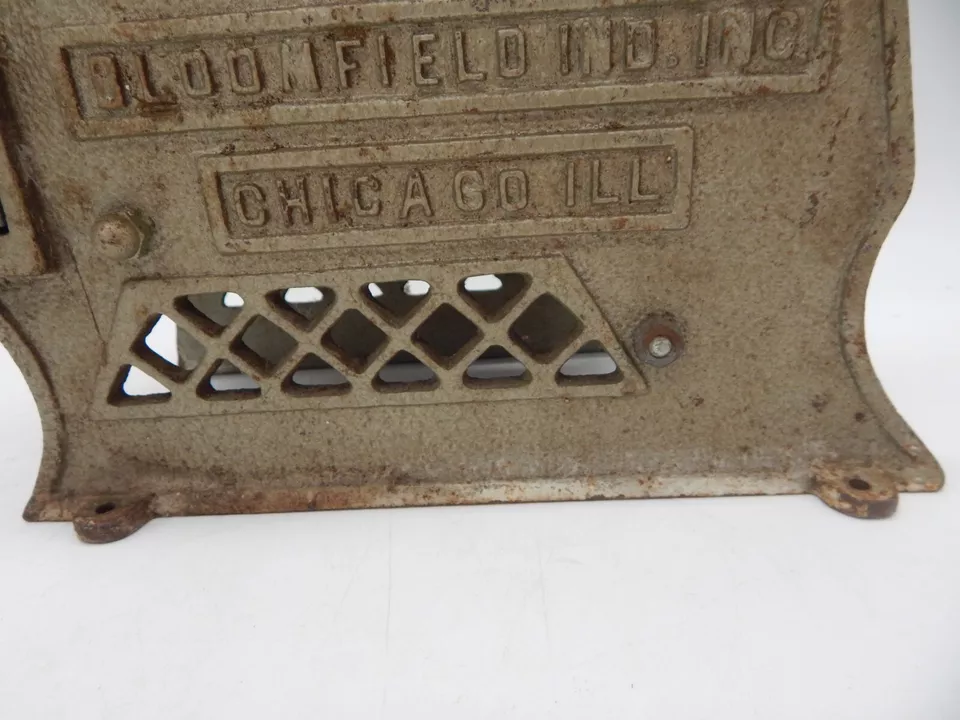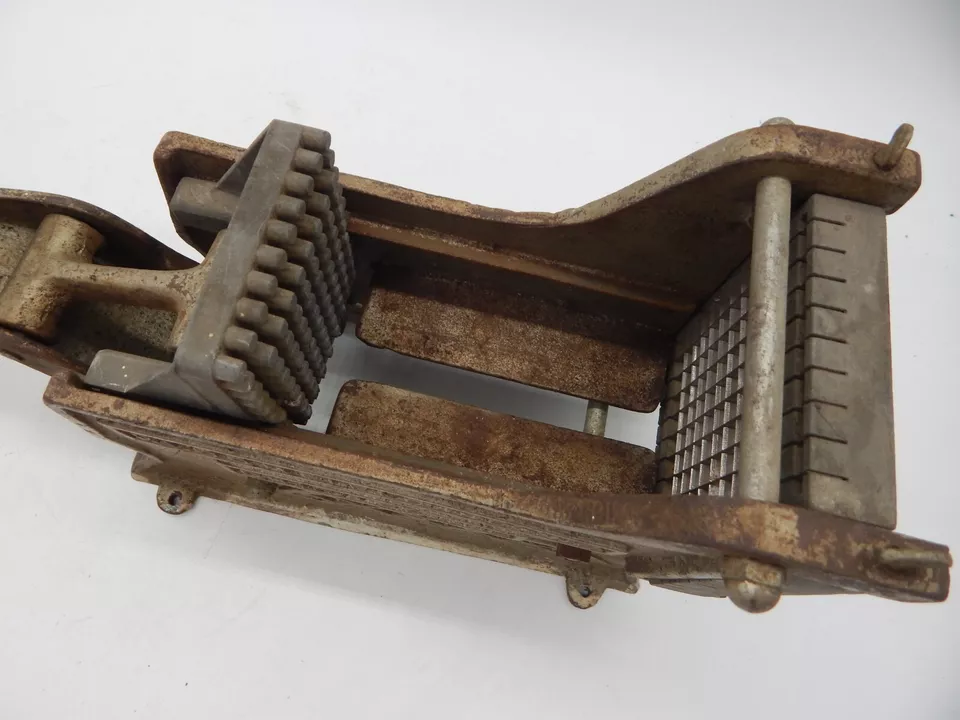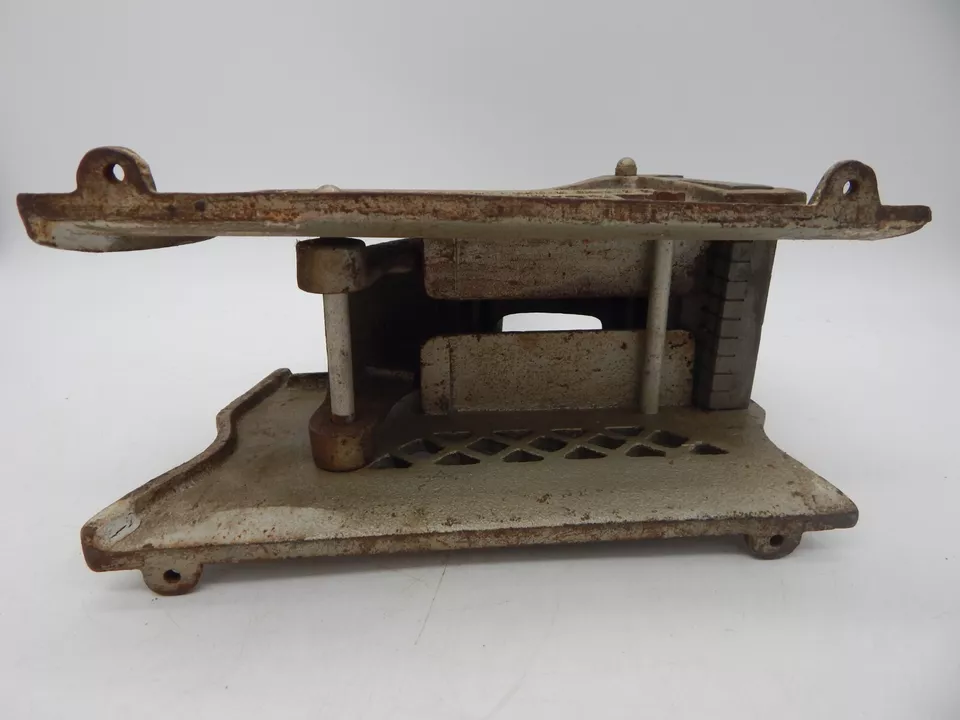Take a good look at this rugged, antique gadget. At first glance, it might appear to be an industrial relic or a tool from a forgotten trade. However, to those familiar with vintage kitchenware, this device is unmistakable—it’s a cast iron potato French fry cutter.
Beyond being a functional kitchen tool, this gadget carries the spirit of another era, where durability and practicality reigned supreme. Let’s explore the fascinating history of this culinary classic and why it remains a nostalgic symbol of craftsmanship.

The Humble Beginnings of the Cast Iron Potato Cutter
The cast iron potato French fry cutter made its debut in the late 19th and early 20th centuries, a period defined by industrial innovation and the rise of practical home goods. These tools were designed to simplify life in the kitchen, helping cooks and small eateries handle potatoes with ease.
Back then, companies like Bloomfield Industries created these gadgets to deliver efficiency. With a sturdy frame and sharp grid blades, these cutters transformed whole potatoes into perfect, uniform fries with a simple pull of a lever. Whether it was for busy diners or bustling home kitchens, these cutters became an essential part of preparing everyone’s favorite side dish.
Why French Fries Became an American Staple
The rise of the cast iron potato cutter coincided with America’s growing love for French fries. During the early 20th century, fries became a ubiquitous menu item, paired with burgers, sandwiches, and fried chicken. Their popularity exploded with the advent of roadside diners and fast food restaurants.
For diners and family-owned eateries, potato cutters became indispensable. They allowed cooks to prepare large quantities of fries quickly, keeping up with the growing demand. At home, these cutters offered families the chance to replicate restaurant-quality fries for celebrations, weekend meals, and even the occasional backyard barbecue.
The Ingenious Simplicity of the Design
The beauty of the cast iron potato cutter lies in its no-frills functionality. It wasn’t reliant on electricity or complex mechanics—just muscle power and a bit of ingenuity. Here’s how it worked:
- You’d place a whole potato into the cutter, lining it up with the grid of sharp blades.
- A pull of the lever would force the potato through the blades, creating even, consistent fries.
- In seconds, you’d have perfect fries ready for the fryer.
The heavy cast iron construction ensured the cutter stayed put during use, while its sharp blades sliced through even the toughest potatoes with ease. It was a tool built to last, with many cutters still in working condition today.

A Nostalgic Slice of Family Life
For those who grew up in the mid-20th century, the cast iron potato cutter often played a starring role in family meals. These devices weren’t just tools—they were part of the traditions that brought people together.
In restaurants, they symbolized efficiency and reliability. In homes, they represented care and effort. Imagine a grandmother pulling out her trusted cutter to prepare fries for a family reunion, or a father slicing fresh potatoes for a Saturday night dinner. These were more than meals—they were memories in the making.
Some diners even turned the process into a spectacle, slicing potatoes in full view of customers. Watching the cutter in action became part of the dining experience, adding a touch of charm to every order of fresh fries.
The Decline and Resurgence of Cast Iron Kitchen Tools
By the mid-20th century, the popularity of manual tools like the cast iron potato cutter began to wane. The rise of electric appliances and industrial slicers made these gadgets seem outdated. Many cutters were relegated to attics, garages, or storage shelves, where they collected dust for years.

However, the tide has turned in recent years. As people embrace sustainable living and seek out vintage treasures, tools like the cast iron potato cutter have found new life. Collectors and enthusiasts prize them not only for their functionality but also for the history and craftsmanship they embody.
Today, these cutters are often displayed in kitchens as decorative items or put back to work, proving that good design never goes out of style.
Why Vintage Tools Are Making a Comeback
The renewed interest in vintage kitchen tools, including cast iron potato cutters, reflects a growing appreciation for simpler times. Here’s why they’re making a comeback:
- Durability: These cutters were built to last a lifetime—something modern gadgets often fail to deliver.
- Simplicity: Their straightforward design makes them easy to use and maintain. No electricity or batteries required!
- Eco-Friendliness: Choosing vintage over new helps reduce waste and supports sustainable living practices.
- Aesthetic Appeal: The rustic charm of cast iron tools fits perfectly with modern farmhouse or industrial kitchen decor.
- Connection to History: Owning and using a vintage tool is like holding a piece of the past in your hands—a tangible reminder of how things used to be.

Caring for Your Cast Iron Potato Cutter
If you’re lucky enough to own one of these cutters, proper care will ensure it remains a functional and beautiful heirloom. Follow these tips to keep it in top condition:
- Clean Thoroughly: After each use, wash the cutter with warm, soapy water to remove any food residue.
- Prevent Rust: Dry it immediately and apply a thin layer of food-safe oil to protect the metal from oxidation.
- Sharpen Blades as Needed: Keeping the blades sharp will ensure clean, easy cuts.
- Store in a Dry Area: Moisture is cast iron’s worst enemy, so choose a cool, dry spot for storage.
A Lasting Legacy of Craftsmanship
The cast iron potato French fry cutter isn’t just a kitchen gadget—it’s a symbol of a bygone era when tools were built to stand the test of time. It represents the ingenuity of its creators and the countless memories it helped create in homes and diners across the country.
For those who remember using one, it’s a trip down memory lane. For younger generations, it’s a fascinating artifact of culinary history. Whether displayed as a collector’s item or put to work in the kitchen, these cutters continue to inspire awe and admiration.
Conclusion: A Slice of Nostalgia That Endures
So, do you remember this from way back when? If you do, chances are your twenties are in the rearview mirror, and you’ve witnessed a piece of history firsthand. The cast iron potato French fry cutter is more than a tool—it’s a testament to practicality, craftsmanship, and the enduring power of shared meals. In a world full of disposable gadgets, this sturdy relic reminds us of a time when things were made to last—and memories were made to savor.


